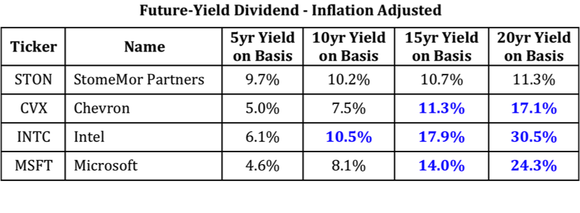Yield seekers are driving up the prices of dividend stocks, thus suppressing yields. If you are one of those seeking better yields, you have to think differently to beat the crowd. This is especially true for those of you on fixed income, or expecting to be when you retire.
The Secret Ingredient
The secret ingredient most dividend investors are blind to is the potential for excellent dividend growth that’s sustainable over many years, if not decades. Dividend investors tend to have much longer time horizons than the average investor, but that dividend growth can make a huge difference sooner than you realize. It can also radically improve your retirement, as it has done for my parents and for my grandparents before them.
A Stark Comparison
To illustrate what dividend growth can do for you, let’s consider the five companies in the table below. It shows the stock price (as of June 15, 2013), dividend yield, and average annual dividend growth over the past 6.5 years. That takes us back to November 2006, well before the financial crisis.

StoneMor Partners L.P. (NYSE:STON) is a master limited partnership (MLP), a type of business known for its high yields. France Telecom SA (ADR) (NYSE:FTE) has an unusually high yield for such a large company, for reasons I’ll elaborate on in a moment. Chevron Corporation (NYSE:CVX), Intel Corporation (NASDAQ:INTC), and Microsoft Corporation (NASDAQ:MSFT) are all big stalwart companies with typically lower yields.
Without any due diligence beyond looking at a company’s yield, you might trot right over to your broker and buy shares of StoneMor Partners L.P. (NYSE:STON) and France Telecom SA (ADR) (NYSE:FTE). But here’s the rub: StoneMor Partners L.P. (NYSE:STON)’s dividend has barely kept pace with inflation, while France Telecom SA (ADR) (NYSE:FTE)’s dividend has actually fallen. Worse, France Telecom SA (ADR) (NYSE:FTE)’s dividend is high because it’s share price has been wasting away for years. Some may call that a buying opportunity, but the price is down because of fears the dividend will fall further. Buyer beware!
Assess the Dividend Growth
Let me now expand my table to include the future yield on your basis for the four companies whose yields have a future. This is the future dividend as a percent of your original cost basis. Let’s look at the yields 5, 10, 15, and 20 years out. I’ll also assume 2% inflation to keep the results in today’s dollars. Over time, the fast growing dividends (Chevron Corporation (NYSE:CVX), Intel Corporation (NASDAQ:INTC), Microsoft Corporation (NASDAQ:MSFT)), even those originally with lower yields, leave the placid growers (StoneMor Partners L.P. (NYSE:STON)) in the dust. Time is the friend of the smart dividend investor. Make time your friend.

Realize that you don’t have to hold exactly the same stocks over these time periods, just like-minded stocks. In this case, we’re comparing high-yield low-yield-growth companies to low-yield high-yield-growth companies. The latter must also have a special sauce that I’ll reveal below.
Here’s a bonus for this strategy: the actual yield stays about the same over the years, which means your share price is climbing at the same rate as the dividend. That’s a 5-times share price increase for Intel over 20 years. It’s actually done even better over the past 20 years. Pretty sweet.
The Special Sauce
What makes the difference between these companies? MLPs, REITs (real estate investment trusts), and most other high yielding companies pour nearly all of their profits into their shareholder dividend payments leaving very little for investment into future growth. Their dividends grow modestly, usually just a little above infaltion. They give you high yields today; but over the long-haul, they offer essentially a fixed income, much like bonds.
France Telecom SA (ADR) (NYSE:FTE), in contrast, is a company trying desperately to evolve out of the beleaguered land-line telecom industry that is being disrupted by mobile technology. Do not invest for dividends in a disrupted industry no matter how high the yield. Dividends are not guaranteed! Not ever.
Chevron Corporation (NYSE:CVX), Intel Corporation (NASDAQ:INTC), and Microsoft Corporation (NASDAQ:MSFT), in contrast, are all in enduring industries that have and will continue to power and shape civilization for decades to come. Look at your relative yield after time has passed. These companies will trounce fixed-income assets over the long-haul, which liberates us from the trap of post-retirement fixed income. Instead, we can watch our wealth actually grow during our retirement, improving our lot with each and every year.
I might add that this strategy will also work absolute wonders if you are in your 20s or 30s as you are looking at six decades of yield growth. Choose wisely using the Secret Ingredient and the Special Sauce, then remember me with a smile when you retire.
I know this works because I’ve watched it work first-hand over the past 50 years with my parents and grandparents. Each year only got better for them. I intend to obtain the same beneficial outcome, and encourage you to do so as well.
Erik Eason has no position in any stocks mentioned. The Motley Fool recommends Chevron, France Telecom (ADR), Intel, and StoneMor Partners. The Motley Fool owns shares of France Telecom (ADR), Intel, Microsoft, and StoneMor Partners. Erik is a member of The Motley Fool Blog Network — entries represent the personal opinion of the blogger and are not formally edited.
The article Look Beyond Yield to Win with Dividends originally appeared on Fool.com is written by Erik Eason.
Copyright © 1995 – 2013 The Motley Fool, LLC. All rights reserved. The Motley Fool has a disclosure policy.






